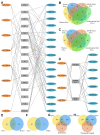MicroRNAs in Extracellular Vesicles of Alzheimer's Disease
- PMID: 37408212
- PMCID: PMC10216432
- DOI: 10.3390/cells12101378
MicroRNAs in Extracellular Vesicles of Alzheimer's Disease
Abstract
Alzheimer's disease (AD) is a neurodegenerative disease with dysfunction of memory, language and thinking. More than 55 million people were diagnosed with AD or other dementia around the world in 2020. The pathology of AD is still unclear and there are no applicable therapies for AD. MicroRNAs (miRNAs) play key roles in AD pathology and have great potential for the diagnosis and treatment of AD. Extracellular vesicles (EVs) widely exist in body fluids such as blood and cerebrospinal fluid (CSF) and contain miRNAs that are involved in cell-to-cell communication. We summarized the dysregulated miRNAs in EVs derived from the different body fluids of AD patients, as well as their potential function and application in AD. We also compared these dysregulated miRNAs in EVs to those in the brain tissues of AD patients aiming to provide a comprehensive view of miRNAs in AD. After careful comparisons, we found that miR-125b-5p and miR-132-3p were upregulated and downregulated in several different brain tissues of AD and EVs of AD, respectively, suggesting their value in AD diagnosis based on EV miRNAs. Furthermore, miR-9-5p was dysregulated in EVs and different brain tissues of AD patients and had also been tested as a potential therapy for AD in mice and human cell models, suggesting that miR-9-5p could be used to design new therapies for AD.
Keywords: Alzheimer’s disease; blood; brain; cerebrospinal fluid; extracellular vesicles; microRNA.
Conflict of interest statement
The authors declare no conflict of interest.
Figures

Similar articles
-
Altered Extracellular Vesicle miRNA Profile in Prodromal Alzheimer's Disease.Int J Mol Sci. 2023 Sep 29;24(19):14749. doi: 10.3390/ijms241914749. Int J Mol Sci. 2023. PMID: 37834197 Free PMC article.
-
Profile of Pathogenic Proteins and MicroRNAs in Plasma-derived Extracellular Vesicles in Alzheimer's Disease: A Pilot Study.Neuroscience. 2020 Apr 15;432:240-246. doi: 10.1016/j.neuroscience.2020.02.044. Epub 2020 Mar 3. Neuroscience. 2020. PMID: 32135232
-
Extracellular Vesicles of Alzheimer's Disease Patients as a Biomarker for Disease Progression.Mol Neurobiol. 2020 Oct;57(10):4156-4169. doi: 10.1007/s12035-020-02013-1. Epub 2020 Jul 17. Mol Neurobiol. 2020. PMID: 32676990
-
Plasma neuronal exosomes serve as biomarkers of cognitive impairment in HIV infection and Alzheimer's disease.J Neurovirol. 2019 Oct;25(5):702-709. doi: 10.1007/s13365-018-0695-4. Epub 2019 Jan 4. J Neurovirol. 2019. PMID: 30610738 Free PMC article. Review.
-
Astrocyte-derived extracellular vesicles: Neuroreparative properties and role in the pathogenesis of neurodegenerative disorders.J Control Release. 2020 Jul 10;323:225-239. doi: 10.1016/j.jconrel.2020.04.017. Epub 2020 Apr 11. J Control Release. 2020. PMID: 32289328 Free PMC article. Review.
Cited by
-
Ginsenoside Rg1 Downregulates miR-9-5p Expression to Modulate SIRT1-Mediated Mitochondrial Dysfunction and Ameliorate Alzheimer's Disease.Mol Neurobiol. 2025 Jun 6. doi: 10.1007/s12035-025-05073-3. Online ahead of print. Mol Neurobiol. 2025. PMID: 40478516
-
Assess Alzheimer's Disease via Plasma Extracellular Vesicle-derived mRNA.medRxiv [Preprint]. 2023 Dec 26:2023.12.26.23299985. doi: 10.1101/2023.12.26.23299985. medRxiv. 2023. Update in: Alzheimers Dement (Amst). 2024 Sep 14;16(3):e70006. doi: 10.1002/dad2.70006. PMID: 38234733 Free PMC article. Updated. Preprint.
-
Exosomal Dynamics and Brain Redox Imbalance: Implications in Alzheimer's Disease Pathology and Diagnosis.Antioxidants (Basel). 2024 Mar 5;13(3):316. doi: 10.3390/antiox13030316. Antioxidants (Basel). 2024. PMID: 38539849 Free PMC article. Review.
-
Mesenchymal Stem Cells from Familial Alzheimer's Patients Express MicroRNA Differently.Int J Mol Sci. 2024 Jan 27;25(3):1580. doi: 10.3390/ijms25031580. Int J Mol Sci. 2024. PMID: 38338859 Free PMC article.
-
Exploring the Role of microRNAs as Blood Biomarkers in Alzheimer's Disease and Frontotemporal Dementia.Int J Mol Sci. 2025 Apr 5;26(7):3399. doi: 10.3390/ijms26073399. Int J Mol Sci. 2025. PMID: 40244285 Free PMC article. Review.
References
-
- Association A. 2022 Alzheimer’s disease facts and figures. Alzheimers Dement. 2022;18:327–406. doi: 10.1002/alz.12638. - DOI
-
- Webster C. What is dementia, why make a diagnosis and what are the current roadblocks? In: CARDI., editor. World Alzheimer Report 2021. Alzheimer’s Disease International; London, UK: 2021. pp. 2–7.
Publication types
MeSH terms
Substances
LinkOut - more resources
Full Text Sources
Medical

